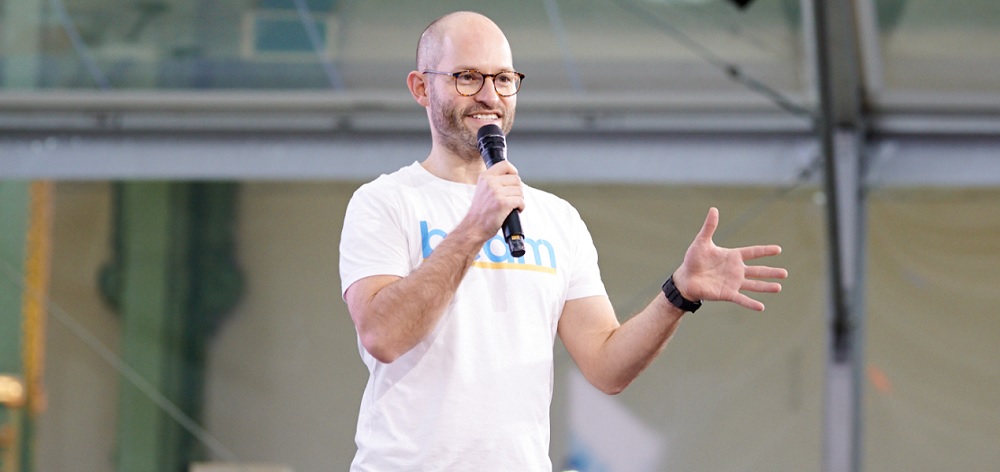As part of our series of interviews with nonprofit leaders doing great work with digital during the pandemic, we spoke to Alex Stephany, founder and CEO of Beam, about the work he and his team are doing to bridge the digital divide for homeless people.
1. Can you tell us more about your role at Beam?
I’m the Founder and CEO of Beam, the world’s first crowdfunding platform for homeless people. Most of my time is spent building the most effective and passionate team at Beam. In the past year, we’ve grown from just 12 people to 25, and we’re looking to hire another 15 people this year.
As well as focusing on hiring, you’ll also find me getting stuck into a bunch of other areas of the business including product, business development and marketing. Right now, I’m focused on building Beam Recruit, our diversity recruitment platform. Beam Recruit is designed to be a hassle-free way for employers to hire candidates from disadvantaged backgrounds to help plug the skills gap. More than 50 companies and charities have hired candidates from us in the past 12 months, and we’re looking to grow that number exponentially.
2. Congratulations on your Queen’s Award for Enterprise! We’d love to hear how this came about
Thank you! The Queen’s Award organisers contacted us about applying for the social mobility category last year. Our goal is to create equality of opportunity at scale, starting by crowdfunding brighter futures for homeless people in London. So it felt like the right fit!
We’ve had a record 12 months supporting more than 250 homeless people into stable jobs and homes and doubling our team. Since launching in November 2017, we’ve now reached a point where we’re supporting more people each month than we did in the first 18 months combined. It’s pretty awesome to achieve this recognition given our considerable growth over the past year or so.
3. Ofcom have recently released a new report into the digital divide during lockdown. How has this issue affected your beneficiaries and what’s your take on the report?
Many homeless people previously relied on public libraries or day centres to access the internet, make online job applications and stay connected. But with COVID-19 closing down these services, digital exclusion during lockdown has been incredibly disempowering for not just our beneficiaries, but disadvantaged communities across the country.
Another stat that rang true for us was the fact that one in five children do not have consistent access to a suitable device for their online home learning. Without laptops, tablets and sufficient data or WiFI, it’s difficult for kids to do their school work and keep up with their peers. Many of our beneficiaries, who have often already faced so much hardship, faced the challenge of homeschooling their children, but lacking the technology and resources to do so.
At Beam, we provide our beneficiaries with smartphones, laptops and WiFi dongles. This enables them to complete online training courses, apply for jobs and help their kids with schoolwork. What’s more, our online Beam Hub allows our beneficiaries to connect directly with their supporters, who often leave messages of encouragement and support alongside their donations.
4. How do you anticipate that the digital divide will affect the people who charities support as we enter the new normal?
At Beam, we’ve seen a 600% increase in demand for our service during the pandemic. Without tailored support and access to tech, it can be very difficult for disadvantaged job-seekers to find employment.
We’re also seeing the impact of the digital divide on older people who lost their jobs as a result of the pandemic. Maybe they didn’t grow up using technology and have spent their career working in non-digital roles. They now face an increasingly digital job market and the prospect of having to retrain and learn new skills later in life, which they may not be able to afford.
For example, Michèle is 55 and used to run a flower shop around the corner from Borough Market until COVID-19 hit. She’s been in the floristry industry her whole life, but found herself at the age of 55 with limited career prospects and at risk of losing her rented flat. She was nervous about doing an office-based job where she’d have to spend all day at a computer. So Beam helped her crowdfund £2,462 from 103 people to retrain as a teaching assistant. Without support from organisations like Beam, Michèle may have found herself homeless and struggling to find work because of a lack of digital skills.
5. What are Beam’s plans to use digital in the next phase of your evolution?
As a Tech for Good platform, we’ve always been focused on how we can use digital to scale Beam to support as many people as possible. Since the start of the pandemic, our service has been fully remote, and we’ve proven that this can work and create efficiencies. By operating our service remotely, we can expand outside London more quickly than we anticipated, which we’re really excited about.
We’re also in the process of building out the ‘Beam Hub’ to support thousands of disadvantaged job-seekers, thanks to funding we received from Nesta as part of its Rapid Recovery Challenge. The Hub can be used for career discovery, job interview tips, CV templates and to find prospective employers – all in one, smartphone-friendly location. At the moment, the Hub is only available to Beam beneficiaries but we plan to scale it so that more and more people can access the resources they need to successfully start work.

